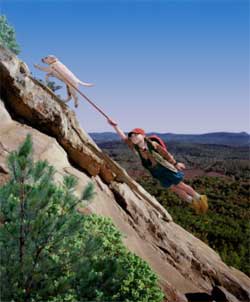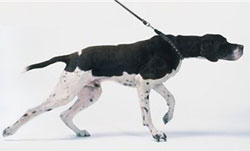Stop leash pulling, one step at a time

I'm sure we've all seen the adverse effects of leash pulling, owner's being dragged around by there dog across the county with reckless abandon.
It's hardly the image we had for seen with our dog, out for a leisurely dog walk, comfortably being obedient and glued to our sides.
Our nice walk has become a tug of war.
Truth is every dog has a tendency to pull on the leash. It's the length of leash that dictates the circumference of the dog's natural exploring instincts.
We can't nor should try to eliminate the dogs natural tendency to sniff around and explore. It's beneficial to have a dog happily exploring as it stimulates his mind with new scent and situations.
However it's not appropriate to have a dog yanking your arm off, and the goal is to have a nice loose leash without pulling.
REWARDS VS PULLING
We know the problem, now for a solution. A dog pulling us is being rewarded by expanding his exploring territory, thus it's a benefit for the dog. What we need to do is to eliminate that behavior by doing the complete opposite.
If the dog pulls we COMPLETELY STOP! This may sound trivial, but in essence the dog has lost his benefits of gaining new area.
At first your dog will be perplexed, but don't move until the dog is either sitting or the leash has been slackened. Then and only then do you proceed with forward movement.
Start with your dog by your side and take one step forward and you stop completely. Give your dog the sit command (preferably) or wait for a slackened leash then you can give him a little kibble from his daily rations.
It's important to give the treat were you intend the dog to begin, which is behind you or at your side.Take another step, stop, and wait for the dog to sit and be attentive towards you.
It's the attention of the dog we need in order to have loose leash walking.This process may sound arduous, and it is, but should not be considered an average walk, instead a training exercise to build on.
Patience and hard work will be rewarded.
Continue on with the exercise, taking progressively more steps until the dog is paying attention to each of your strides and sits automatically when you stop.

After progressing to 40 or so steps without any leash pulling, swiftly turn around and walk in the opposite direction.
This sudden change in direction reinforces the dogs need to pay attention to our every move.
Your dog may be caught off guard by this direction change, but continue on. You'll probably find him looking at you more intently, which is exactly what our goals are. Reward him for attentive behavior as well as no pulling.
The intentions here are to have a loose leash without leash pulling, but can be further involved if your goals are to have your dog walk beside you at a comfortable pace.
This second video shows us the same principles with "clicker training". Different method, but same results. What ever works!
Use a baiting technique with your hand to solidify the concept in your dogs mind. Have a kibble treat in your hand and have your dog follow your hand while walking.
Your dog should be rewarded when it touches your hand while walking, and keeping a proper distance behind you. Later a hand touch command is useful in the "heel" command.
Have fun with it, and remember a dog is a sniffing explorer. The initial excitement and anticipation of a walk may still result in some leash pulling behavior, but will quickly calm down as your dog adjusts to his new found manners. Our goal is to have the tools and understand the answers.
Best wishes from dog care basics

Brand new look! Hope you like.
A victory against puppy-mills in Missouri after Prop B vote
Jon Stewart's "The Daily Show" spin on Prop B...hillarious (11/11/10) Clip#2







